Durga Puja, one of the grandest festivals in India, celebrates the victory of Goddess Durga over the demon Mahishasura, a timeless reminder that good always triumphs over evil. Traditionally observed with grand pandals, devotional songs, and vibrant cultural performances, this celebration has also found a special place in homes.
Families gather to honor Maa Durga with love, prayer, and beautiful decorations. If you’re looking for Durga Puja decoration at home ideas that combine devotion with elegance, brass idols and diyas can add a timeless charm.
Brass Standing Durga Maa Murti with Lion ( 6 Inch) Brass Maa Symbol Diya (5 Inch)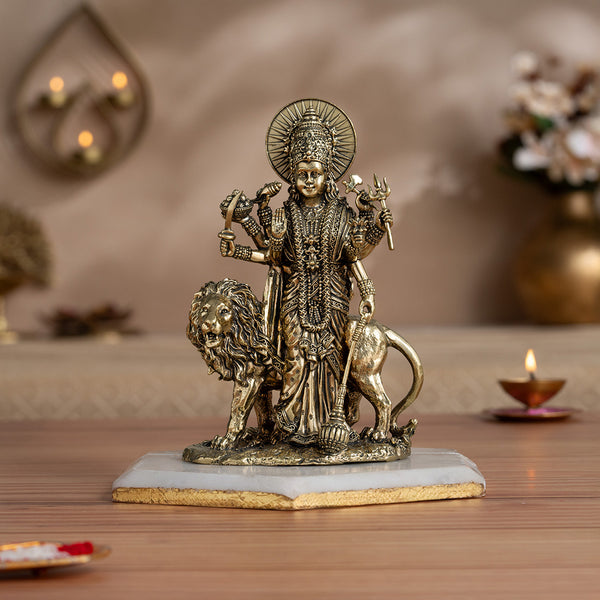
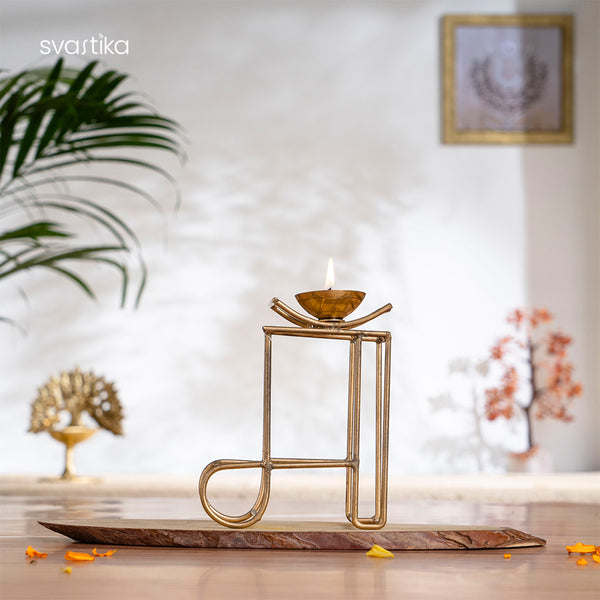
The Story That Inspires Durga Puja Decorations
According to Hindu mythology, Mahishasura, the buffalo demon, terrorized the heavens and earth. Neither gods nor humans could defeat him due to a powerful boon. The divine energy of all gods combined to create Goddess Durga, a warrior goddess armed with celestial weapons. Riding a lion, she fought Mahishasura for nine days and nights, finally slaying him on the tenth day.
This victory day is celebrated as Vijayadashami, with the preceding nine days marked as Navratri in many regions and Durga Puja in Bengal and other states. This legend is why every element of Durga Puja decor reflects power, positivity, and divine grace.
Durga Puja Decoration Ideas for a Spiritual Ambience
When creating a devotional setup at home, the aim is to bring the divine presence of Maa Durga into your space. Durga Puja decoration ideas can range from traditional to minimalistic, but all should focus on purity, light, and warmth.
-
Use brass or gold-toned idols to reflect divine energy.
-
Place fresh flowers like marigold and hibiscus (beloved to Goddess Durga) around the mandap.
-
Incorporate rangoli designs with rice flour and flower petals.
-
Arrange decorative diyas in patterns to illuminate the space naturally.
These ideas create an inviting and devotional atmosphere where prayers feel more heartfelt.
Brass 8 Armed Maa Durga Idol Sitting on Lion Brass Round Pooja Chowki (6.5 Inch)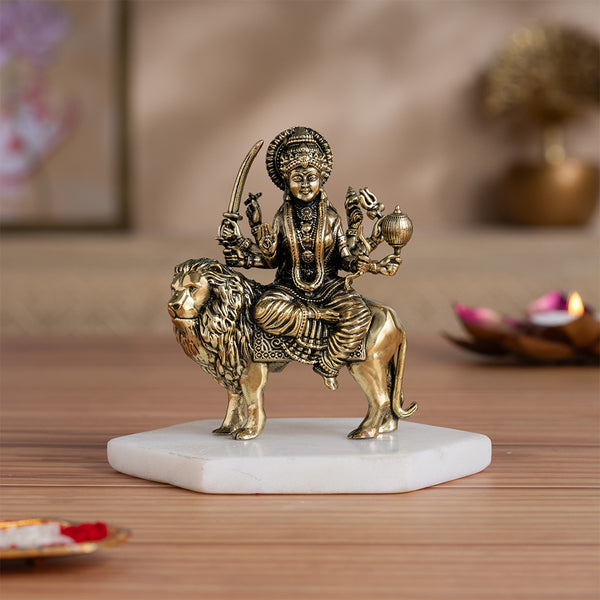
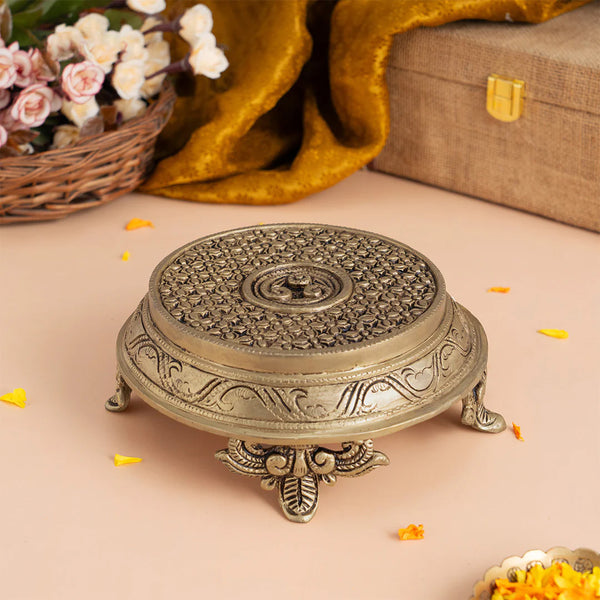
Durga Maa Decoration with Brass Idols
Durga maa decoration is incomplete without a centerpiece idol. Brass idols are especially favored because they symbolize prosperity and retain their beauty for decades. A well-polished brass Durga idol, with intricate carvings, becomes the heart of your puja setup. You can place the idol on a wooden chowki draped with a red or yellow cloth, symbolizing energy and auspiciousness.
Pair the idol with brass diyas for soft, flickering light. This combination not only looks regal but also aligns with Vastu principles, inviting positive vibrations into your home.
Creative Durga Mata Decoration for the Festive Season
If you’re seeking Durga mata decoration ideas beyond the usual floral garlands, try:
-
Fabric Backdrops: Use silk or cotton dupattas in red, orange, or gold behind the idol.
-
Torans: Hang mango leaf and marigold garlands at the entrance of your puja room.
-
Light Curtains: Place warm LED string lights behind your mandap for a glowing background.
-
Sacred Symbols: Place kalash with coconut and mango leaves near the idol.
These elements make your Maa Durga setup visually captivating while maintaining cultural authenticity.
Maa Durga Decoration at Home for Smaller Spaces
For compact homes, maa durga decoration at home can be just as beautiful with the right choices:
-
Opt for a medium-sized brass idol on a low table or chowki.
-
Use a single brass urli filled with water and floating flowers in front of the idol.
-
Place 3–5 small brass diyas instead of large lamps for a balanced look.
-
Choose foldable backdrops to set up and store easily after the festival.
Even in a small space, these elements make your puja corner festive and inviting.
Lotus Urli Bowl with Stand (Set of 10) Brass Loban Burner (Incense Burner) (4 Inch)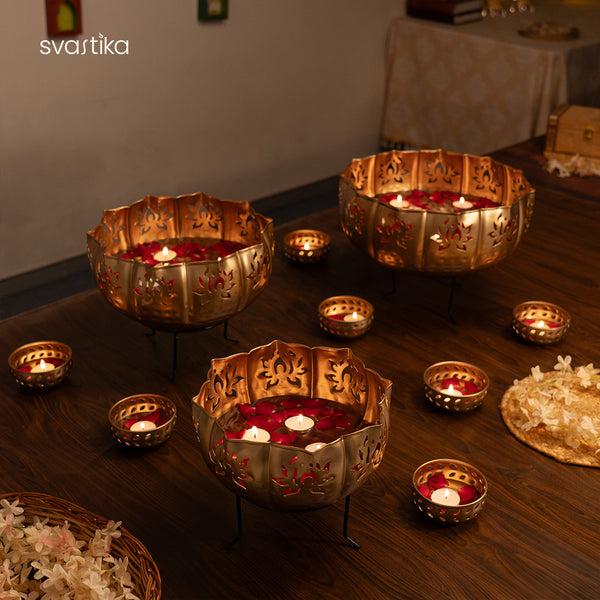
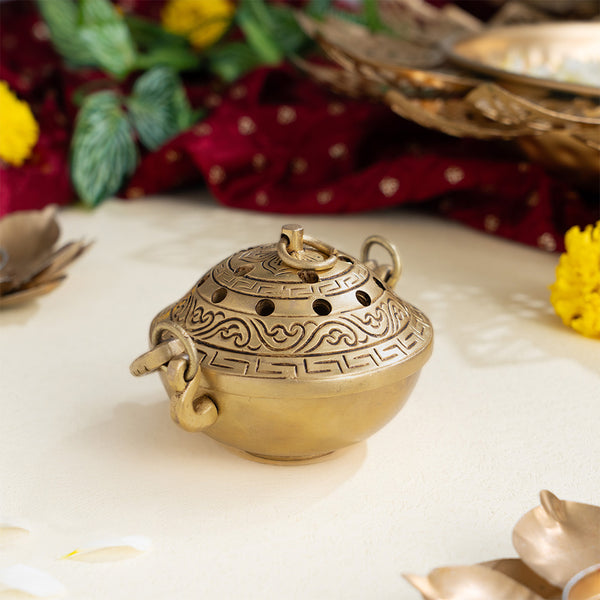
Choosing the Right Durga Puja Decoration Items
The magic of the festival lies in the details. Durga puja decoration items can include:
-
Brass idols and diyas
-
Rangoli stencils
-
Fresh flower garlands
-
Kalash sets
-
Puja thalis with kumkum, rice, and incense holders
When sourced thoughtfully, these items enhance the puja experience and become heirlooms for future celebrations.
Brass Floral Meenakari Pooja Thali (10 Inch)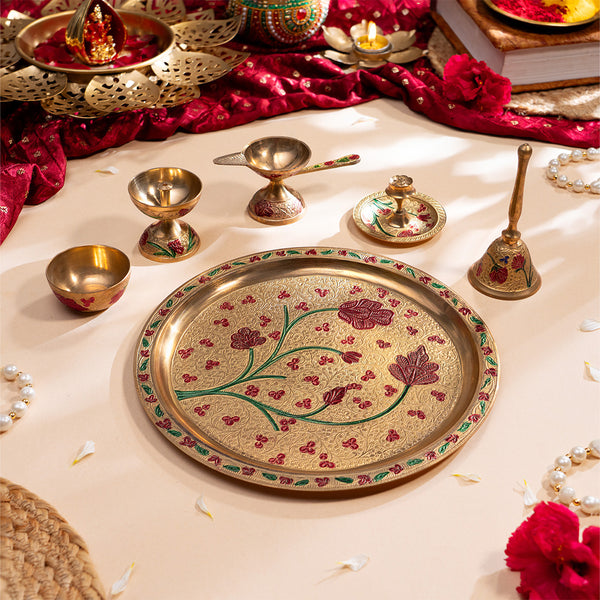
Traditional Durga Pooja Decoration for the Devout Home
If you want your setup to feel like a mini-pandal, Durga pooja decoration can include layered floral arrangements, draped saree backdrops, and multiple tiers for displaying various forms of the goddess. You can also create a thematic decor inspired by different Durga temples in India, using photos and symbolic objects.
FAQs On Durga Puja Decoration:
1) Why Durga Puja is celebrated?
Durga Puja is celebrated to honor Maa Durga’s victory over Mahishasura, symbolizing the triumph of good over evil. It is also a celebration of feminine divine energy (Shakti).
2) Why do we celebrate Durga Puja?
We celebrate Durga Puja to seek the blessings of Maa Durga for strength, prosperity, and protection, and to commemorate her legendary victory in Hindu mythology.
3) How do we celebrate Durga Puja?
Durga Puja is celebrated with rituals like setting up an altar, offering flowers and prasad, lighting diyas, reciting mantras, performing aarti, and decorating the space with flowers and festive items.
4) What are the main decoration themes for Durga Puja at home?
Popular themes include floral decoration, brass idol setups, eco-friendly arrangements, and colorful fabric backdrops with traditional diyas.
5) How can I decorate for Durga Puja at home?
Use brass idols, fresh flowers, colorful fabrics, and decorative diyas to create a spiritual and festive space.
6) What are the essential items for Durga Puja decoration?
Brass idols, diyas, chowkis, flower garlands, kalash sets, and rangoli materials are key essentials.
7) Can Durga Puja be celebrated in small apartments?
Yes, with compact idols, foldable backdrops, and minimalistic decoration, you can create a beautiful setup even in a limited space.
Also Read: How Many Hands Does Goddess Durga Have and What Do They Symbolize? |








